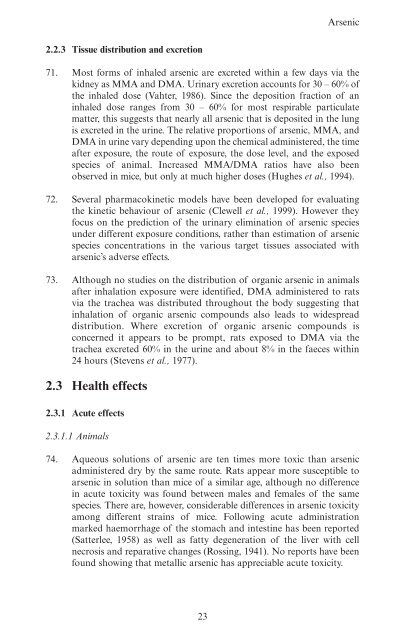Guidelines for Metals and Metalloids in Ambient ... - ARCHIVE: Defra
Guidelines for Metals and Metalloids in Ambient ... - ARCHIVE: Defra
Guidelines for Metals and Metalloids in Ambient ... - ARCHIVE: Defra
You also want an ePaper? Increase the reach of your titles
YUMPU automatically turns print PDFs into web optimized ePapers that Google loves.
Arsenic<br />
2.2.3 Tissue distribution <strong>and</strong> excretion<br />
71. Most <strong>for</strong>ms of <strong>in</strong>haled arsenic are excreted with<strong>in</strong> a few days via the<br />
kidney as MMA <strong>and</strong> DMA. Ur<strong>in</strong>ary excretion accounts <strong>for</strong> 30 – 60% of<br />
the <strong>in</strong>haled dose (Vahter, 1986). S<strong>in</strong>ce the deposition fraction of an<br />
<strong>in</strong>haled dose ranges from 30 – 60% <strong>for</strong> most respirable particulate<br />
matter, this suggests that nearly all arsenic that is deposited <strong>in</strong> the lung<br />
is excreted <strong>in</strong> the ur<strong>in</strong>e. The relative proportions of arsenic, MMA, <strong>and</strong><br />
DMA <strong>in</strong> ur<strong>in</strong>e vary depend<strong>in</strong>g upon the chemical adm<strong>in</strong>istered, the time<br />
after exposure, the route of exposure, the dose level, <strong>and</strong> the exposed<br />
species of animal. Increased MMA/DMA ratios have also been<br />
observed <strong>in</strong> mice, but only at much higher doses (Hughes et al., 1994).<br />
72. Several pharmacok<strong>in</strong>etic models have been developed <strong>for</strong> evaluat<strong>in</strong>g<br />
the k<strong>in</strong>etic behaviour of arsenic (Clewell et al., 1999). However they<br />
focus on the prediction of the ur<strong>in</strong>ary elim<strong>in</strong>ation of arsenic species<br />
under different exposure conditions, rather than estimation of arsenic<br />
species concentrations <strong>in</strong> the various target tissues associated with<br />
arsenic’s adverse effects.<br />
73. Although no studies on the distribution of organic arsenic <strong>in</strong> animals<br />
after <strong>in</strong>halation exposure were identified, DMA adm<strong>in</strong>istered to rats<br />
via the trachea was distributed throughout the body suggest<strong>in</strong>g that<br />
<strong>in</strong>halation of organic arsenic compounds also leads to widespread<br />
distribution. Where excretion of organic arsenic compounds is<br />
concerned it appears to be prompt, rats exposed to DMA via the<br />
trachea excreted 60% <strong>in</strong> the ur<strong>in</strong>e <strong>and</strong> about 8% <strong>in</strong> the faeces with<strong>in</strong><br />
24 hours (Stevens et al., 1977).<br />
2.3 Health effects<br />
2.3.1 Acute effects<br />
2.3.1.1 Animals<br />
74. Aqueous solutions of arsenic are ten times more toxic than arsenic<br />
adm<strong>in</strong>istered dry by the same route. Rats appear more susceptible to<br />
arsenic <strong>in</strong> solution than mice of a similar age, although no difference<br />
<strong>in</strong> acute toxicity was found between males <strong>and</strong> females of the same<br />
species. There are, however, considerable differences <strong>in</strong> arsenic toxicity<br />
among different stra<strong>in</strong>s of mice. Follow<strong>in</strong>g acute adm<strong>in</strong>istration<br />
marked haemorrhage of the stomach <strong>and</strong> <strong>in</strong>test<strong>in</strong>e has been reported<br />
(Satterlee, 1958) as well as fatty degeneration of the liver with cell<br />
necrosis <strong>and</strong> reparative changes (Ross<strong>in</strong>g, 1941). No reports have been<br />
found show<strong>in</strong>g that metallic arsenic has appreciable acute toxicity.<br />
23
















